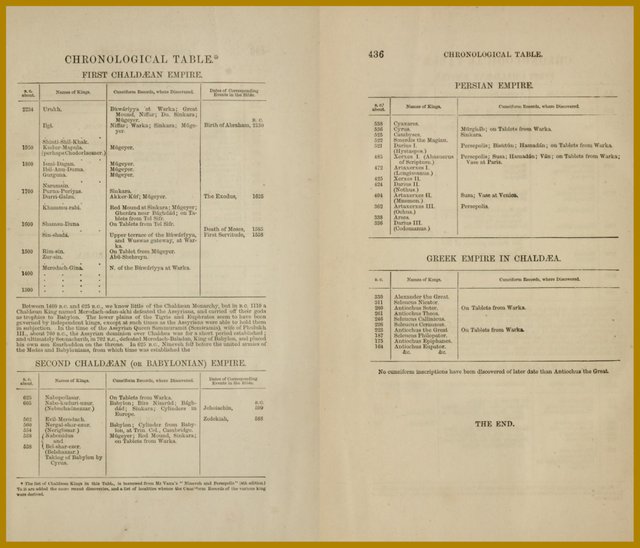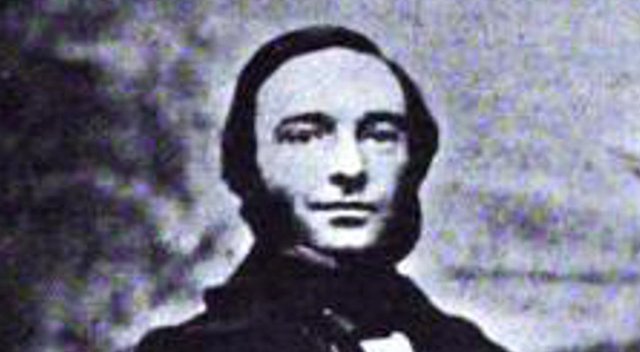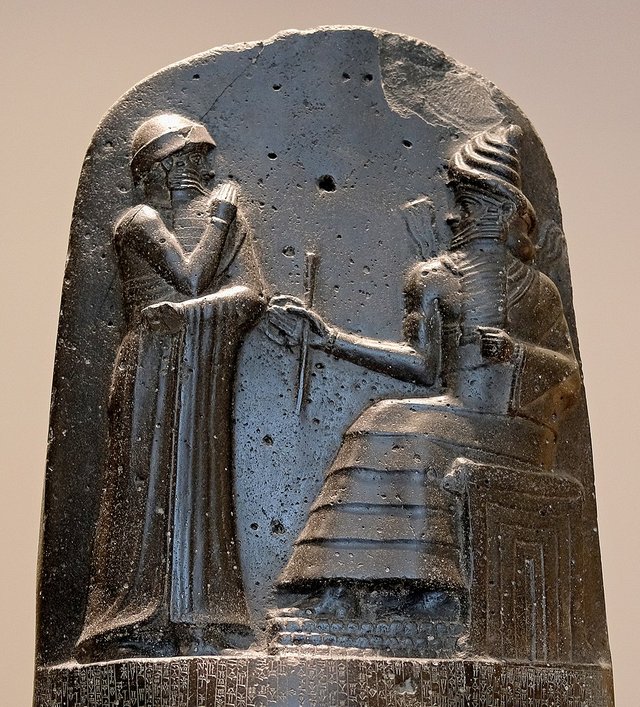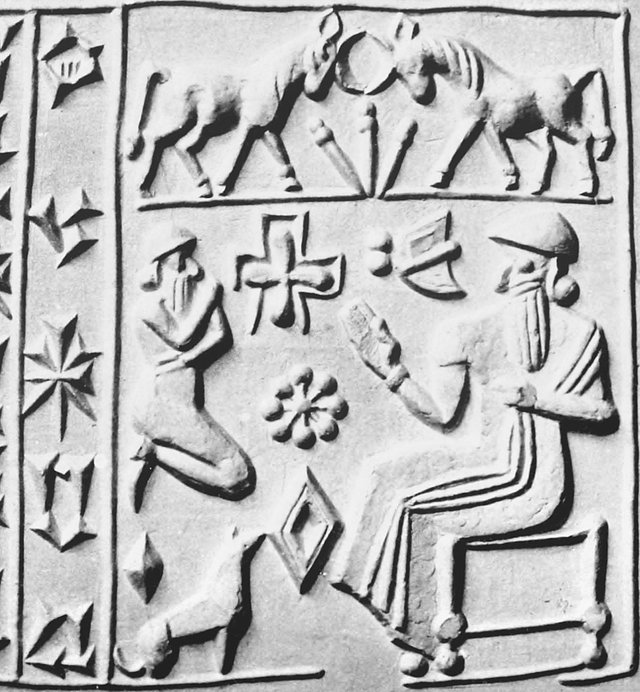
The Restoration of Ancient History is a paper delivered in November 1994 by Gunnar Heinsohn, Professor Emeritus at the University of Bremen in Germany, at a symposium in Portland, Oregon. This paper questions the conventional chronology of ancient history and offers in its place a radical reconstruction—the so-called Short Chronology, of which Heinsohn is the principal architect. In this series of articles, we are taking a closer look at the evidence cited in this paper in favour of Heinsohn’s new chronology:
Heinsohn recognizes four periods in the history of Mesopotamia before the conquests of Alexander the Great:
| Dates BCE | Upper Mesopotamia | Lower Mesopotamia |
|---|---|---|
| 540-330 | Persian Empire | Persian Empire |
| 620-540 | Empire of the Medes | Second Chaldaeans |
| 750-620 | Assyrian Empire | Assyrian Empire and Scythians |
| 1150-750 | Early Assyrians | First Chaldaeans |
In this article we will conclude our survey of Part 4 of Heinsohn’s lecture, in which he asks the question: How could historical periods, so well known from Greek authors, be shown to be “elusive”, whereas in the very same territories modern archaeology has revealed sensationally ancient civilizations, unknown before the late 19th century?
In the last article we saw how the 5th-century Christian historian Eusebius of Caesarea devised a chronology of ancient history in an attempt to synchronize Biblical and Classical sources. Being a Christian bishop, Eusebius gave precedence to the former. This Chronicon, particularly in its partial Latin translation by Jerome, became the basis for the chronology of the ancient world until quite recently:
Modern archaeology openly and undisputedly kept the Biblical dating scheme up to the late 19th century, as may be seen from Loftus’ famous Travels and Researches in Chaldaea and Susiana (London, 1857). With the focus on the South of Mesopotamia, he still retains only the well-known four major post-Chalcolithic periods of Greek historiography, but now ties the end of the 3rd to Abraham’s late -3rd millennium biblical birthdate. Thereby he cannot help but create a gap to the Second or Neo-Chaldaean empire beginning ca. -620. Loftus may have been confident that sooner or later other researchers would come up with a multitude of rulers, empires and wars, to colour the staggering blank of one-and-a-half millennia. He himself had no means whatsoever to meet this horrendous challenge. “Sumerians”, “Akkadians”, “Old-Babylonians”, “Mitanni”, “Middle-Assyrians” etc., were not yet known in his lifetime. (Heinsohn)

William Kennett Loftus was one of the pioneers of Biblical archaeology. His discoveries include the ancient city of Uruk (the Biblical Erech), the Ziggurat of Ur, and the so-called Burnt Palace of Ashurnasirpal II at Nimrud (Kalhu). Loftus adopted a Fundamentalist approach to Scripture. For example:
By general consent of Jews, Sabaeans, and Mohammedans, the burial-place of the Prophet Daniel is acknowledged to be at Shúsh, and a building at the west foot of the great mound is consecrated to him, and held in the utmost reverence by these different races. Pilgrims from all parts flock to “Danyel” to offer up prayers and bury their dead.
In the book which bears his name in our edition of the Scriptures, frequent allusion is made to Shushan the palace. As history, tradition, and, to some extent, the names, agree, we are justified in assuming that the ruins of Shúsh represent the Shushan of the Bible, and that Daniel was really buried on the spot. We have, however, the authority of an Arab historian for concluding that the present tomb of Daniel is but a comparatively modern edifice, and that the bones of the Prophet are not enshrined within its walls. (Loftus 317)
Heinsohn claims that Loftus ties the end of the third historical period of Lower Mesopotamia to Abraham’s late -3rd millennium biblical birthdate. I do not understand this. As can be seen from his chronological tables, Loftus synchronizes the first period (First Chaldæan Empire) with Abraham. Furthermore, Heinsohn’s staggering blank of one-and-a-half millennia before 625 BCE is in reality only 775 years long and corresponds to the period of Assyrian domination. Even this, however, is not a blank:
Between 1400 B.C. and 625 B.C., we know little of the Chaldæan Monarchy, but in B.C. 1110 a Chaldæan King named Merodach-adan-akhi defeated the Assyrians, and carried off their gods as trophies to Babylon. The lower plains of the Tigris and Euphrates seem to have been governed by independent kings, except at such times as the Assyrians were able to hold them in subjection. In the time of the Assyrian Queen Sammuramit (Semiramis), wife of Phulukh III., about 760 B.C., the Assyrian dominion over Chaldæa was for a short period established; and ultimately Sennacherib, in 702 B.C., defeated Merodach-Baladan, King of Babylon, and placed his own son Esarhaddon on the throne. In 625 B.C., Nineveh fell before the united armies of the Medes and Babylonians, from which time was established the [Second Chaldæan (or Babylonian) Empire]. (Loftus 436)

Triplication
One of Gunnar Heinsohn’s most remarkable achievements is his discovery that modern archaeologists have unwittingly triplicated some of the empires of the Ancient World, placing three copies of each of them in three different timeframes. One copy might correspond to the actual historical empire, while the other two copies are ghost empires that never really existed. For example, the so-called Akkadian Empire of Sargon the Great in Lower Mesopotamia, the Hyksos Empire in Egypt, and the Old Assyrian Empire in Upper Mesopotamia all refer in Heinsohn’s opinion to the Assyrian Empire of the Classical historians. Typically, the real history belongs in the first millennium BCE, with duplicates and triplicates placed in the second and third millennia respectively.
The biblical triplication of Herodotus’ time span could only be achieved on paper. What one was able to do with the pen could not be repeated with the spade. Even if we use a chronology of 3,000 or 1,000 pre-Christian years of high civilization, this will not change the number and thickness of strata actually in the ground. They remain unalterably the same. Therefore, biblical chronology, applied to Herodotus’ four Ancient Near Eastern periods, between the Chalcolithicum and Hellenism, created huge gaps of up to 1,500 or more years at individual sites. These notorious lacunae were eventually filled by historians, who multiplied actual time spans by three. They performed this miracle by heaping three stratagroups from different areas, but from contemporary periods, on top of each other on the pages of the chronology books. Of course, scholarly justifications were needed. These justifications arose from the use of three different dating schemes, which made contemporary strata of different areas look like successive periods, whose centres of power were located in different areas. The three schemes used were (i) fundamentalist dates of Assyriology, (ii) pseudo-astronomical Sothic dates of Egyptology, and (iii) dates of Greek historiography. (Heinsohn)
In some cases, the result is a duplication. For example, the Mitanni duplicate in the 2nd millennium the Medes of the first millennium. The Neo-Assyrian Empire is a duplicate of the Persian Empire. (Actually, Heinsohn believes that the so-called Old Babylonians, or First Dynasty of Babylon, are a triplicate of the Persian Empire, but here I follow Emmet Sweeney in rejecting this particular identification.)
In the late 19th century, Assyriologists broke the link with the Bible, relying instead on king-lists and eponym-lists. In Heinsohn’s opinion, however, this change was largely cosmetic, as the resulting chronology was still more-or-less the same Bible-based chronology of Eusebius:
Again, the Assyriologist will object, and confidently point to the abolishment of Abraham, who is no longer considered historical.
This erasion of Abraham from chronology books was begun in the late l9th century and completed in the 70’s of the 20th century. Then, it was established that the Abraham-lore dates from the Persian period (-550 onwards) and later. Chronology building had to start from scratch. As far as Mesopotamia is concerned, the materials used today consist of the eponym- and king-lists gradually being unearthed—without the stratigraphical levels in which they are found always being identified and taken seriously, however. Abraham is hardly ever given a mention in the work now being carried out on these lists. Yet, the dates of the “new” chronology do not differ very much from the dates used up to the l9th century, when Abraham was still openly viewed as the ultimate chronological anchor-point. (Heinsohn)

The new anchor-point for the chronology of Lower Mesopotamia was provided by Hammurabi, the sixth king of the First Dynasty of Babylon:
How were Abraham-dates kept-or “co-dependently” backed by the lists—without keeping Abraham as a historical figure? This was done through Hammurabi, the lawgiver of the mysterious, but most powerful Martu/Amorites of the so-called Old-Babylonian period: “The date of Hammurabi is the keystone of the chronology of the second and third millennia B.C.” (G. Roux, Ancient Iraq, Harmondsworth, 1980, p. 43). His approximate date, however, derives from the contact between Abraham and Amraphel in Gen. 14:1. For a long time, Assyriologists have equated Amraphel with Hammurabi, whose date, thus, was also calculated via Abraham’s Biblical birthdate in the -21st century. Only after 1960, the identification of Amraphel with Hammurabi was eventually dropped, but the latter’s Abraham date was kept up to this very day. Only the time-span between the years -2300 to -1700, around which Hammurabi oscillated within the last 90 years, is due to internal evidence. The absolute position of the time-span, around 2000, still is due to Abraham’s date. Thus, the expunging of the name of Abraham from scientific research does not indicate the application of a convincing new method to prove the existence of developed civilizations as early as the third millennium, but merely casts an embarrassed—as well as cosmetic—veil over the original pious basis for this early date. (Heinsohn)
Heinsohn goes on the identify the Amorites of the First Dynasty of Babylon with the Amardi, the Persian tribe to which he believes the Achaemenid rulers of the Persian Empire belonged. This hypothesis has led Heinsohn to identify Hammurabi with Darius the Great. As I mentioned above, neither I nor Emmet Sweeney find this tenable. According to Sweeney’s model of the Short Chronology, the Amorites of the First Dynasty of Babylon were Scythians, who ruled the city for about eighty years from roughly 700 BCE, after which the native Chaldaeans regained their independence (Sweeney 188-190).
In Egypt, Sothic dating methods that Heinsohn calls pseudo-astronomical were used to bolster the official timeline:
Egyptology’s chronology is not only pseudo-astronomical—which many an Egyptologist will readily concede—but also no less fundamentalist than Assyriology’s, which even a cautious Egyptologist will thoroughly reject. Again, the very great age of Egyptian civilization—rooted, in the final reckoning, in Abraham’s visit to the Nile—was tacitly maintained. In addition, an independent method of objectively dating the past was sought. The result, following in the wake of l9th-century Egyptologists, and embodied in the canonisation by Eduard Meyer (1904) that was to be so rich in consequences, was the adoption of an astronomical retrocalculation procedure.
As with Mesopotamia, Egyptian datings were now to be arrived at with pen and paper rather than by stratigraphical excavation. (Heinsohn)

This diagram reflects the model Heinsohn presented in The Restoration of Ancient History in 1994, but it does not necessarily reflect his latest views on the subject. For example, Heinsohn now equates the Neo-Assyrians with the Persians. And as I have said, Emmet Sweeney rejects the identification of the Old Babylonians with the Persians:
Before taking another step, we should note here that were we to equate the Old Babylonians (coming before the Kassites), with the Persians, then we must as a consequence place the Kassites, as well as the Egyptian Eighteenth and Nineteenth Dynasties, after the Persians. This alone, in and of itself, completely refutes the equation of Old Babylonians and Persians. But if they were not Persians, who were they?
In order to answer that question, we need to examine the broader sweep of Mesopotamian history and archaeology in the light of our new chronology. Like the Kassites in southern Mesopotamia, the Mitanni in northern Mesopotamia were also contemporaries of the Eighteenth Dynasty. I am in agreement with Heinsohn in seeing the Mitanni as the Mede conquerors of the Old Assyrian (Akkadian) Empire, an event that must have occurred around 700 BC. Now, whilst the Mitanni immediately replaced the Akkadians in northern Mesopotamia, in southern Mesopotamia their place was eventually taken (in some areas at least) by the so-called “Neo-Sumerian” Third Dynasty of Ur. These kings, with names like Ur-Nammu, Shulgi, and Ibbi-Sin, are rightly identified by Heinsohn with the Neo-Chaldeans (as distinct from Neo-Babylonian) kings who controlled Babylonia during the time of the Medes. Thus the last of these men, Ibbi-Sin, who was carried in bonds to Anshan, was identical to the Nabonidus of the Cyrus Prism, who was also carried off in bonds to Anshan.
For me, therefore, and for Heinsohn, the Third Dynasty of Ur was contemporary, in part at least, with the Egyptian Eighteenth and Nineteenth Dynasties. Yet we have already seen that the Kassites, who occur at many sites in southern Mesopotamia, were also contemporary with the Egyptian Eighteenth and Nineteenth Dynasties. Hence it is hardly open to question that the Kassites and Ur Dynasty 3 kings were one and the same Neo-Chaldeans Dynasty.
Yet here there arises a difficulty. If the Kassites and Ur Dynasty 3 rulers were alter-egos of each other, this means that the latter kings, just like the Kassites, have to come after Hammurabi’s Old Babylonians. Again, we must ask: Who, then, were they?
Classical sources record that after the fall of Assyria the Medes took northern Mesopotamia, but Babylon was ruled for a period of about eighty years by a dynasty of Scythian kings. Only after this time, which by our reckoning must have been around 620 BC, did the Neo-Chaldean take control of the region. These Neo-Chaldean, or Kassites, or Neo-Sumerians, were led to power by the great leader Nabu-apil-iddin (Nabopoladdan), also known (in his Chaldean guise) as Ur-Nammu and (in his Kassite guise) as Burnaburiash. It was this mighty Babylonian king who corresponded with Akhnaton, probably around 620 BC. The Old Babylonian dynasty, the line of kings which directly preceded that of Nabopoladdan/Ur-Nammu/Burnaburiash, was that of the Scythians (or Gutians), the former nomads who seized Lower Mesopotamia, and held it for 80 years.
Hammurabi was no Persian—he was a Scythian.
Before finishing, I wish to state that Heinsohn is not to be blamed for the confusion that surrounds the Old Babylonian question. The term has been applied far too loosely to kings and dynasties that were actually centuries apart. Thus Heinsohn is right in seeing Ibbi-Sin, threatened by the Martu, as the Neo-Chaldean Nabonidus (Nabu-natsir) threatened by the Persian Mardians. But the Martu were not the Old Babylonians, as Heinsohn has stated. Their kings, apparently, had names reminiscent of some borne by the Old Babylonians, and this may go some way to explain the confusion. Yet the Old Babylonians did not follow the Third Dynasty of Ur, they actually preceded them, though in the “Sumerian” cities over which the Third Dynasty ruled, they were called Gutians. Only in the Kassite (Semitic-speaking) regions were they known as Old Babylonians. (Sweeney 189-190)
And that’s a good place to stop.

References
- Gunnar Heinsohn, Catastrophism, Revisionism, and Velikovsky, in Lewis M Greenberg (editor), Kronos: A Journal of Interdisciplinary Synthesis, Volume 11, Number 1, Kronos Press, Deerfield Beach, FL (1985)
- Gunnar Heinsohn, The Restoration of Ancient History, Mikamar Publishing, Portland, OR (1994)
- Gunnar Heinsohn, Die Sumerer gab es nicht [The Sumerians Never Existed], Frankfurt (1988)
- Gunnar Heinsohn, Heribert Illig, Wann lebten die Pharaonen? [When Did the Pharaohs Live?], Eichborn Verlag, Frankfurt (1990)
- Gunnar Heinsohn, M Eichborn, Wie alt ist das Menschengeschlecht? [How Old Is Mankind?], Mantis Verlag, Gräfelfing, Munich (1996)
- William Kennett Loftus, Travels and Researches in Chaldæa and Susiana, Robert Carter & Brothers, New York (1857)
- Emmet Sweeney, The Ramessides, Medes, and Persians, Ages in Alignment, Volume 4, Algora Publishing, New York (2008)
Image Credits
- Gunnar Heinsohn: © Freud, Creative Commons License
- William Kennett Loftus: Robert Spence Watson, _The History of the Literary and Philosophical Society of Newcastle-upon-Tyne (1793-1896)_, Walter Scott, Limited, London (1897), Public Domain
- Hammurabi and the God Shamash: Hammurabi Stele, Louvre Museum, Paris, © Mbzt (photographer), Creative Commons License
- Seal Dedicated to Burnaburiash II: Richard Arthur Martin, Ancient Seals of the Near East, Field Musuem of Natural History, Chicago (1940), Public Domain
Online Resources
